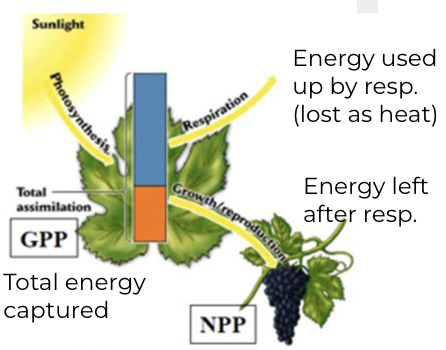AP Environmental Science - The Whole Shabang
1/151
There's no tags or description
Looks like no tags are added yet.
Name | Mastery | Learn | Test | Matching | Spaced |
|---|
No study sessions yet.
152 Terms
Unit 1 - The Living World - Ecosystems (6-8%): Levels of Ecology, from Simple to Complex
Individual
Population
Community
Ecosystem
Biome
Unit 1 - The Living World - Ecosystems (6-8%): Individual
one organism (elk)
Unit 1 - The Living World - Ecosystems (6-8%): Population
group of individuals of same species (elk herd)
Unit 1 - The Living World - Ecosystems (6-8%): Community
all living organisms in an area
Unit 1 - The Living World - Ecosystems (6-8%): Ecosystem
all living and nonliving things in an area (plants, animals, rocks, soil, water, air)
Unit 1 - The Living World - Ecosystems (6-8%): Biome
the plants and animals found in a given region (determined by climate) Ex: tropical rainforest
Unit 1 - The Living World - Ecosystems (6-8%): Organism Interactions
Competition
Predation
Mutualism
Commensalism
Unit 1 - The Living World - Ecosystems (6-8%): Competition
organisms fighting over a resource like food or shelter; limits population size
Unit 1 - The Living World - Ecosystems (6-8%): Predation
one organism using another for energy source (hunters, parasites)
Unit 1 - The Living World - Ecosystems (6-8%): Mutualism
relationship that benefits both organisms (coral reef)
Unit 1 - The Living World - Ecosystems (6-8%): Commensalism
relationship that benefits one organism and doesn’t impact the other (birds nest in trees)
Unit 1 - The Living World - Ecosystems (6-8%): Predation (+/-)
Herbivores
True Predators
Parasites
Parasitoids
Unit 1 - The Living World - Ecosystems (6-8%): Herbivores
(plant eaters) eat plants for energy (giraffe & tree)
Unit 1 - The Living World - Ecosystems (6-8%): True Predators
(carnivores) kill and eat prey for energy (leopard & giraffe)
Unit 1 - The Living World - Ecosystems (6-8%): Parasites
uses a host organism for energy, often without killing the host & often living inside host
Ex: mosquitoes, tapeworms, sea lamprey
Unit 1 - The Living World - Ecosystems (6-8%): Parasitoids
lays eggs inside a host organism; eggs hatch & larvae eat host for energy
Ex: parasitic wasps, bot fly
Unit 1 - The Living World - Ecosystems (6-8%): Symbiosis
sym = together | bio = living | osis = condition
Any close and long-term interaction between two organisms of different species
Mutualism (+/+) commensalism (+/0), and parasitism (+/-) are all symbiotic relationships
Unit 1 - The Living World - Ecosystems (6-8%): Mutualism
Organisms of different species living close together in a way that benefits both
Ex: (animals) Coral provides reef structure & CO2 for algae; algae provide sugars for coral to use as energy
Lichen = composite organism of fungi living with algae; algae provide sugars (energy) & fungi provides nutrients
Unit 1 - The Living World - Ecosystems (6-8%): Competition
Reduces population size since there are fewer resources available & fewer organisms can survive
Resource partitioning
Temporal partitioning
Spatial partitioning
Morphological partitioning
Unit 1 - The Living World - Ecosystems (6-8%): Resource Partitioning
different species using the same resource in different ways to reduce competition
Unit 1 - The Living World - Ecosystems (6-8%): Temporal Partitioning
Using resource at different times, such as wolves & coyotes hunting at different times (night vs. day)
Unit 1 - The Living World - Ecosystems (6-8%): Spatial Partitioning
using different areas of a shared habitat (different length roots)
Unit 1 - The Living World - Ecosystems (6-8%): Morphological Partitioning
using different resources based on different evolved body features
Unit 1 - The Living World - Ecosystems (6-8%): Biome
the plants & animals found in a region; based on yearly temperature + precipitation (climate)
Rain forest
Tiaga
Temperature Deciduous Forest
Grasslands
Desert
Tundra
The community of organisms (plants & animals) in a biome are uniquely adapted to live in that biome
Camels and cacti
Shrubs and wildflowers
Unit 1 - The Living World - Ecosystems (6-8%): Biome Characteristics
Latitude (distance from equator) determines temperature & precipitation which is why biomes exist in predictable pattern on earth
Biome chart can also predict where on earth biomes are found
Tundra & Boreal = higher latitude (60°C +)
Temperate = mid latitude (30° - 60°C)
Tropical closer to equator
Biomes are defined by average annual temperature & precipitation
Unit 1 - The Living World - Ecosystems (6-8%): Nutrient Availability
Plants need soil nutrients to grow, so availability determines which plants can survive in a biome
Ex: frozen soils of tundra don’t allow nutrients in dead organic matter to be broken down by decomposers, causing:
Low soil nutrients
Low water availability
Few plants survive here
Unit 1 - The Living World - Ecosystems (6-8%): Tropical Rainforest
nutrient-poor soil
(high temperature & rainfall —> rapid decomposition of organic matter
acidic soil + high rainfall —> nutrient leaching)
Unit 1 - The Living World - Ecosystems (6-8%): Boreal Forest
nutrient-poor soil
(low temperature & low decomposition rate of organic matter)
Unit 1 - The Living World - Ecosystems (6-8%): Temperate Forest
nutrient-rich soil
(lots of dead organic matter - leaves & warm temperature/moisture for decomposition)
Unit 1 - The Living World - Ecosystems (6-8%): Shifting Biomes
Biomes shift in location on earth as climate changes
Ex: warming climate will shift boreal forests further north as tundra permafrost soil melts & lower latitudes become too warm for aspen & spruce
Unit 1 - The Living World - Ecosystems (6-8%): Characteristics of Aquatic Biomes
Salinity
Flow
Depth
Temperature
Unit 1 - The Living World - Ecosystems (6-8%): Salinity
How much salt there is in a body of water, determines which species can survive & usability for drinking (Fresh water vs. estuary (a partially enclosed coastal body of water where fresh water from rivers and streams mixes with saltwater from the ocean) vs. ocean)
Unit 1 - The Living World - Ecosystems (6-8%): Flow
Determines which plants & organisms can survive, how much O2 can dissolve into water
Unit 1 - The Living World - Ecosystems (6-8%): Depth
Influences how much sunlight can penetrate and reach plants below the surface for photosynthesis
Unit 1 - The Living World - Ecosystems (6-8%): Temperature
Warmer water holds less dissolved O2 so it can support fewer aquatic organisms
Unit 1 - The Living World - Ecosystems (6-8%): Freshwater: Rivers & Lakes
Rivers have high O2 due to flow mixing water & air, also carry nutrient-rich sediments (deltas & flood plains = fertile soil)
Lakes = standing bodies of fresh H2O (key drinking water source
Littoral
Limnetic
Profundal
Benthic
Unit 1 - The Living World - Ecosystems (6-8%): Littoral
shallow water w/emergent plants

Unit 1 - The Living World - Ecosystems (6-8%): Limnetic
where light can reach (photosynthesis)
No rooted plants, only phytoplankton
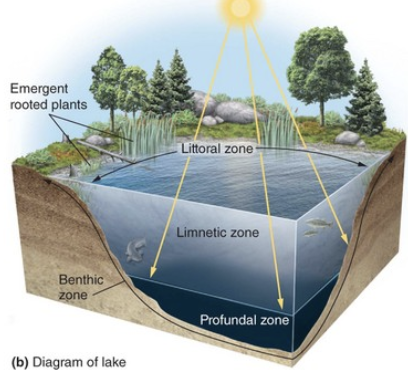
Unit 1 - The Living World - Ecosystems (6-8%): Profundal
too deep for sunlight (no photosynthesis)
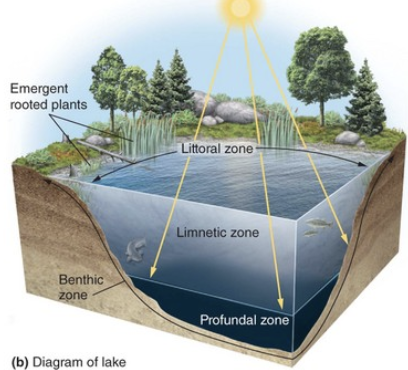
Unit 1 - The Living World - Ecosystems (6-8%): Benthic
murky bottom where inverts (bugs) live, nutrient-rich sediments
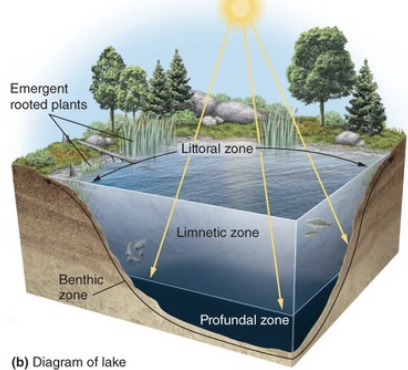
Unit 1 - The Living World - Ecosystems (6-8%): Freshwater: Wetlands
area with soil submerged/saturated in water for at least part of the year, but shallow enough for emergent plants
Plants living here have to be adapted to living with roots submerged in standing water (cattails, lily pads, reeds)
Unit 1 - The Living World - Ecosystems (6-8%): Benefits of Wetlands
Stores excess water during storms, lessening flood damage to property
Recharges groundwater by absorbing rainfall into soil
Roots of wetland plants filter pollutants from water draining through
High plant growth rates growth rates due to lots of water & nutrients (dead organic matter) in sediments
Unit 1 - The Living World - Ecosystems (6-8%): Estuaries
areas where rivers empty into the ocean
Mix of fresh & salt water (species adapt to this ex: mangrove trees)
High productivity (plant growth) due to nutrients in sediments deposited in estuaries by river
Salt Marsh
Mangrove Swamps
Unit 1 - The Living World - Ecosystems (6-8%): Salt Marsh
Estuary hab. along coast in temperate climates
Breeding ground for many fish & shellfish species
Unit 1 - The Living World - Ecosystems (6-8%): Mangrove Swamps
Estuary hab. along coast of tropical climates
Mangrove trees with long, stilt roots stabilize shoreline & provide habitat for many species of fish & shellfish
Unit 1 - The Living World - Ecosystems (6-8%): Coral Reef
Warm shallow waters beyond the shoreline; most diverse marine (ocean) biome on earth
Mutualistic relationship between coral (animals) & algae (plants)
Coral take CO2 out of ocean to create calcium carbonate exoskeleton (the reef) & also provide CO2 to the algae
Algae live in the reef and provide sugar (energy) to the coral through photosynthesis
Both species rely on the other:
Coral couldn’t survive without energy from algae
Algae need the home of the reef & CO2 from the coral
Unit 1 - The Living World - Ecosystems (6-8%): Intertidal Zones
Narrow band of coastline between high & low tide
Organisms must be adapted to survive crashing waves & direct sunlight/heat during low tide
Ex: Barnacles, sea stars, crabs that can attach themselves to rocks
Shells & tough outer skin can prevent drying out (desiccation) during low tides
Different organisms are adapted to live in different zones
Ex: Spiral wrack (type of seaweed) curls up & secretes mucus to retain water during low tide
Unit 1 - The Living World - Ecosystems (6-8%): Open Ocean
So large that algae & phytoplankton of ocean produce a lot of earth’s O2 & absorb a lot of atmospheric CO2
Low productivity per m2 as algae & phytoplankton can only survive in photic zone
Unit 1 - The Living World - Ecosystems (6-8%): Photic Zone
area where sunlight can reach (photosynthesis)
Unit 1 - The Living World - Ecosystems (6-8%): Aphotic Zone (abyssal)
area too deep for sunlight
Species rely on detritus from photic zone or chemosynthetic microbes at hydrothermal vents for energy
Unit 1 - The Living World - Ecosystems (6-8%): Productivity
the rate of formation of biomass in the ecosystem. It can also be referred to as the energy accumulated in the plants by photosynthesis.
Unit 1 - The Living World - Ecosystems (6-8%): Carbon Cycle Overview
Movement of molecules that contain Carbon (CO2, glucose, CH4) between sources and sinks
Some steps are very quick (fossil fuel combustion); some are very slow (sedimentation & burial)
Leads to imbalance in which reservoirs or sinks are storing carbon
Atmosphere is key C reservoir: increasing levels of C in atm. Leads to global warming
Carbon sink
Ocean (algae & sediments), plants, soil
Carbon source:
Fossil fuel (oil, coal, nat gas) combustion
Animal aq. (cow burps & farts = CH4)
Deforestation, releases CO2 from trees
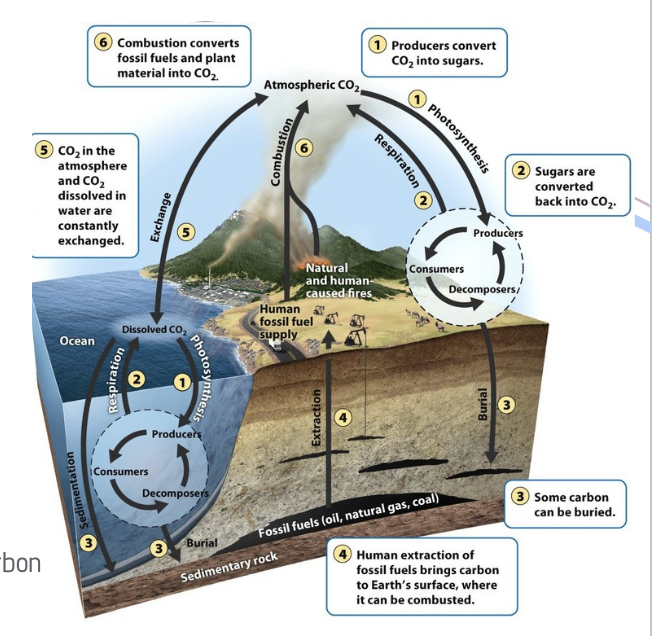
Unit 1 - The Living World - Ecosystems (6-8%): Key Carbon Reservoir
Atmosphere; Leads To Global Warming
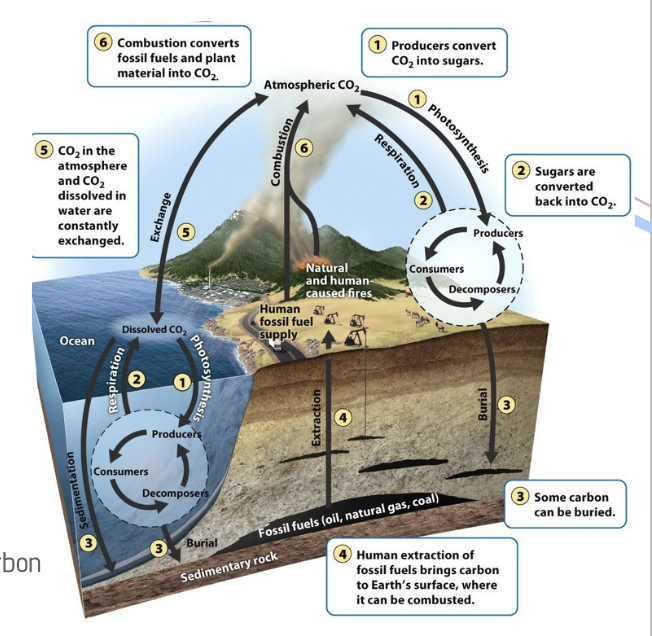
Unit 1 - The Living World - Ecosystems (6-8%): Carbon Sink
reservoir that take in more carbon than it releases
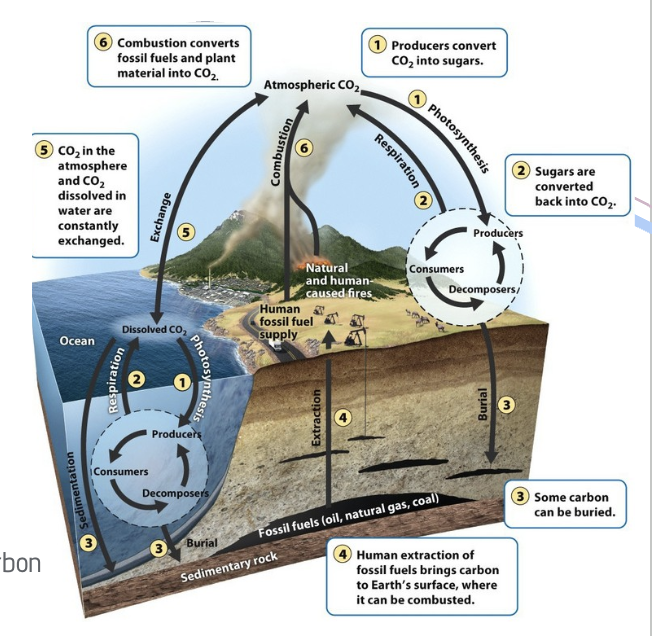
Unit 1 - The Living World - Ecosystems (6-8%): Carbon Source
reservoir that releases more carbon than it takes in
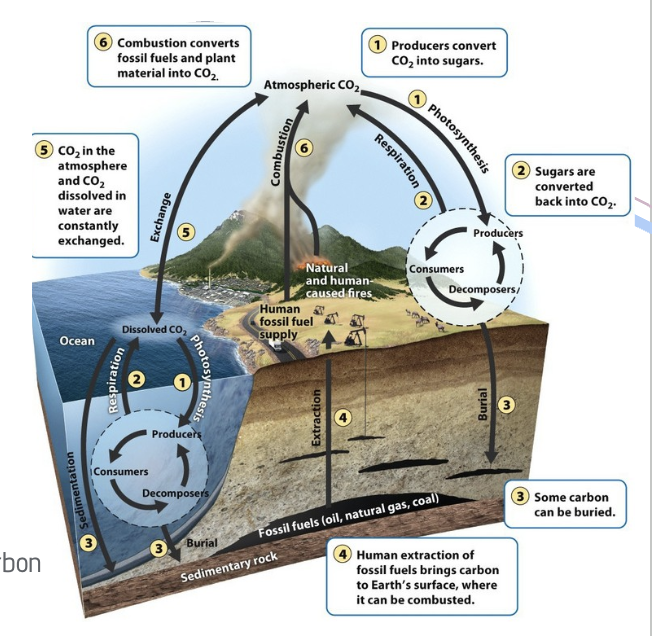
Unit 1 - The Living World - Ecosystems (6-8%): Photosynthesis
Plants, algae, phytoplankton
Removes CO2 from the atmosphere & converts it to glucose
Glucose = biological form of C & stored (chemical) energy in form of sugar
CO2 sink
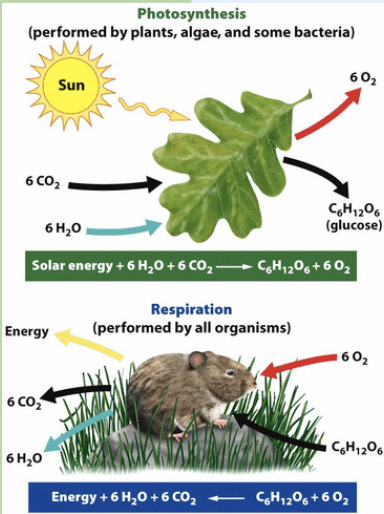
Unit 1 - The Living World - Ecosystems (6-8%): Cellular Respiration
Done by plants & animals to release stored energy
Use O2 to break glucose down & release energy
Releases CO2 into atmosphere
CO2 source (adds CO2 to atmosphere)
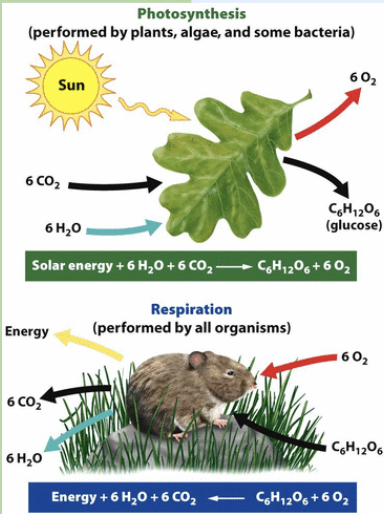
Unit 1 - The Living World - Ecosystems (6-8%): Photosynthesis and Cellular Respiration
Both processes are very quick
Cycle C between biosphere & atmosphere in balanced amount (no net C increase in atmosphere)
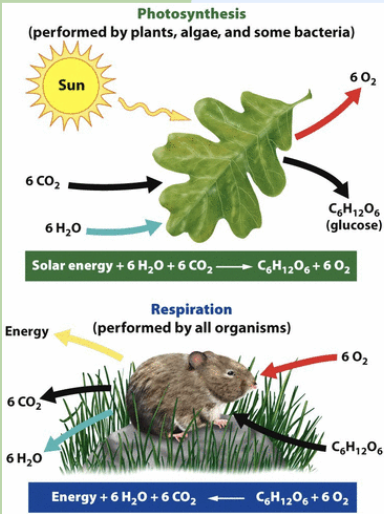
Unit 1 - The Living World - Ecosystems (6-8%): Ocean & Atmosphere
Direct Exchange
Happens very quickly & in equal directions, balancing levels of CO2 between atmosphere & ocean
Because of direct exchange, increasing atmospheric CO2 also increases ocean CO2 leading to ocean acidification
Algae & phytoplankton
Coral, mollusks, and some zooplankton
Sedimentation
Burial
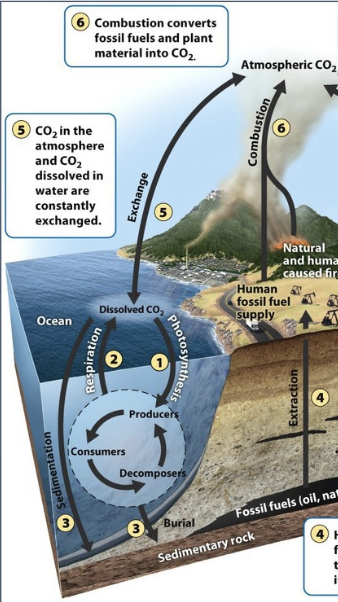
Unit 1 - The Living World - Ecosystems (6-8%): Direct Exchange
CO2 moves directly between atmosphere & the ocean by dissolving into & out of ocean water at the surface
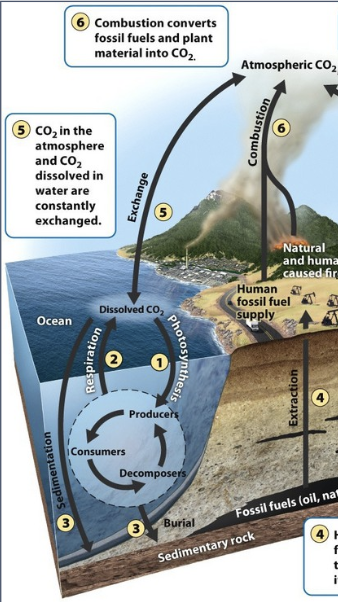
Unit 1 - The Living World - Ecosystems (6-8%): Ocean Acidification
the decreasing pH of the ocean, primarily due to the absorption of excess carbon dioxide (CO2) from the atmosphere. This process is a major concern because it negatively impacts marine ecosystems and the organisms that live there.
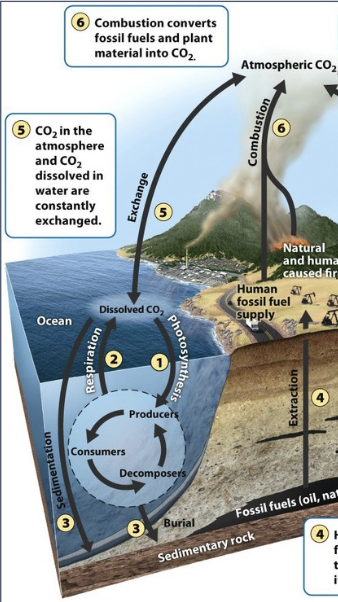
Unit 1 - The Living World - Ecosystems (6-8%): Algae & phytoplankton
take CO2 out of the ocean & atmosphere through photosynthesis
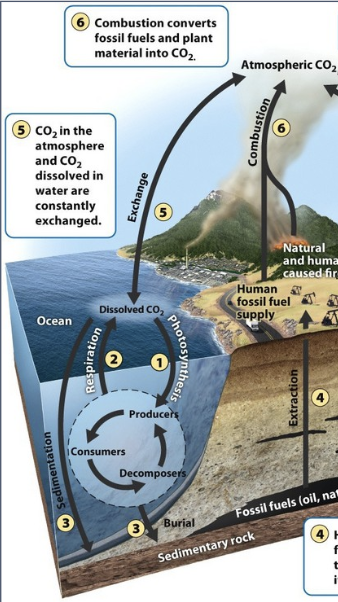
Unit 1 - The Living World - Ecosystems (6-8%): Coral, mollusks, and some zooplankton
Also take CO2 out of the ocean to make calcium carbonate exoskeletons
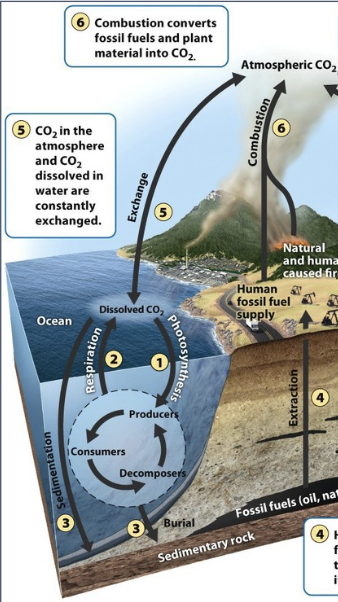
Unit 1 - The Living World - Ecosystems (6-8%): Sedimentation
Calcium carbonate precipitates out as sediment & settles on ocean floor
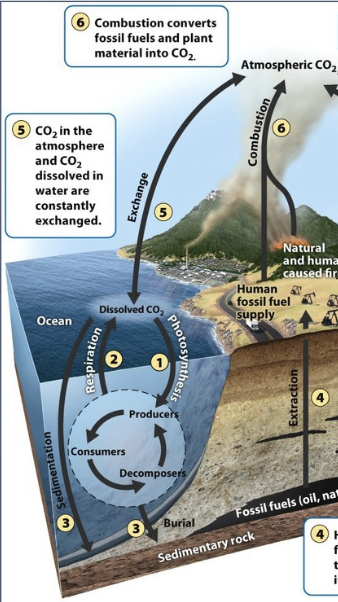
Unit 1 - The Living World - Ecosystems (6-8%): Burial
Over long periods of time, pressure of water compresses C-containing sediments on ocean floor into sedimentary rock (limestone, sandstone) - long-term C reservoir
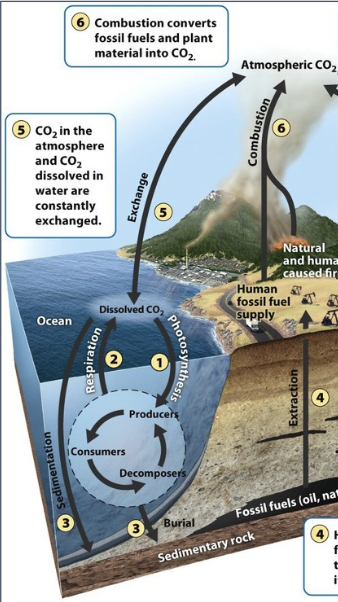
Unit 1 - The Living World - Ecosystems (6-8%): Burial, Extraction, & Combustion
Burial
Sediments (bits of rock, soil, organic matter) compacted into sedimentary rock by weight of overlying rock layers or water
Fossil Fuels (FF)
Extraction & Combustion
Burial (formation of FFs) takes far longer than extraction & combustion, which means they increase concentration of CO2 in atmosphere
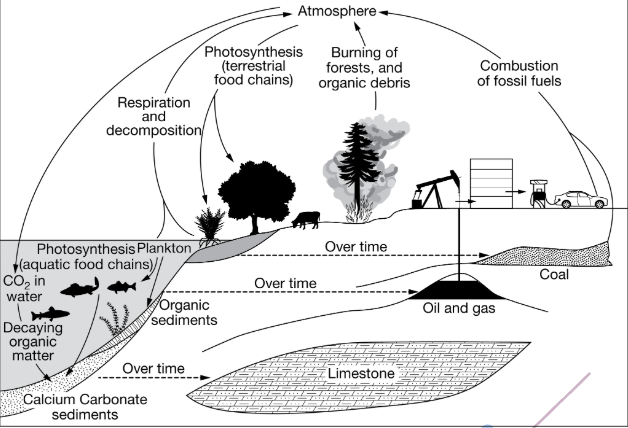
Unit 1 - The Living World - Ecosystems (6-8%): Burial
slow, geological process that stores C in underground sinks like sedimentary rock or fossil fuels
Sediments (bits of rock, soil, organic matter) compacted into sedimentary rock by weight of overlying rock layers or water
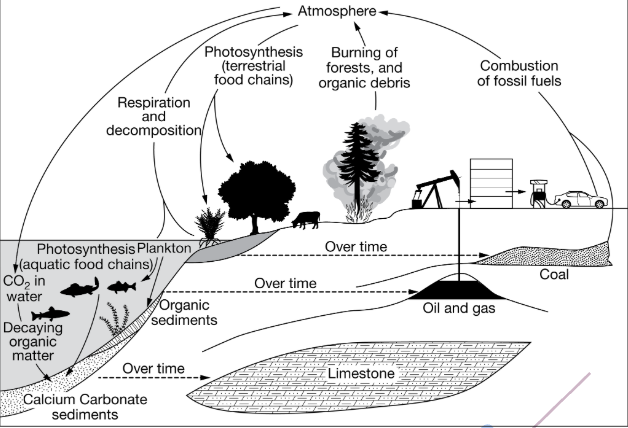
Unit 1 - The Living World - Ecosystems (6-8%): Fossil Fuels (FF)
formed from fossilized remains of organic matter into coal (ex. plants) or oil (ex. plankton). Their decomposition produces natural gas (CH4)

Unit 1 - The Living World - Ecosystems (6-8%): Extraction & Combustion
Digging up or mining FFs & burning them as energy source: releases CO2 into atmosphere
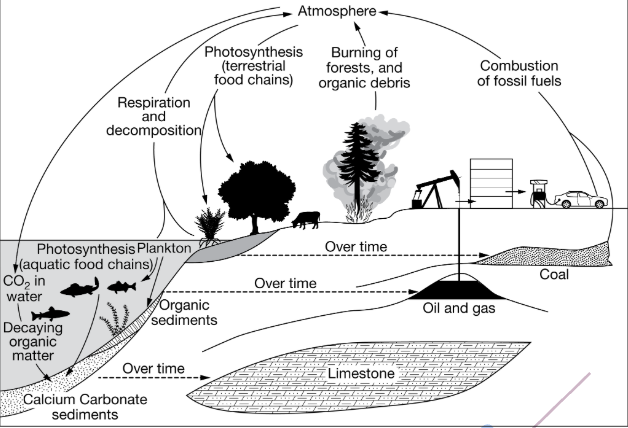
Unit 1 - The Living World - Ecosystems (6-8%): Nitrogen Cycle Overview
Movement of N-containing molecules between source & sinks/reservoirs
Source release N into atmosphere; sinks take N out of the atmosphere in increasing amounts
N reservoirs hold Nh for relatively short periods of time compared to C cycle
Ex: plants, soil, atmosphere
Atmosphere = main N reservoir
N in atmosphere exists mostly as N2 gas, which is not useable by plants or animals
N = critical plant & animal nutrient
All living things need N for DNA & amino acids to make proteins
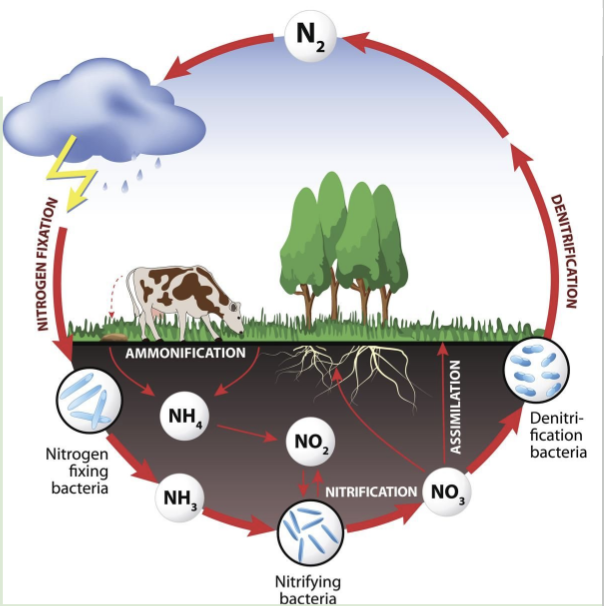
Unit 1 - The Living World - Ecosystems (6-8%): Nitrogen Fixation
Process of N2 gas being converted into biologically available (useable by plants) NH3 (ammonia) or NO3 (nitrate)
Biotic fixation
Abiotic fixation
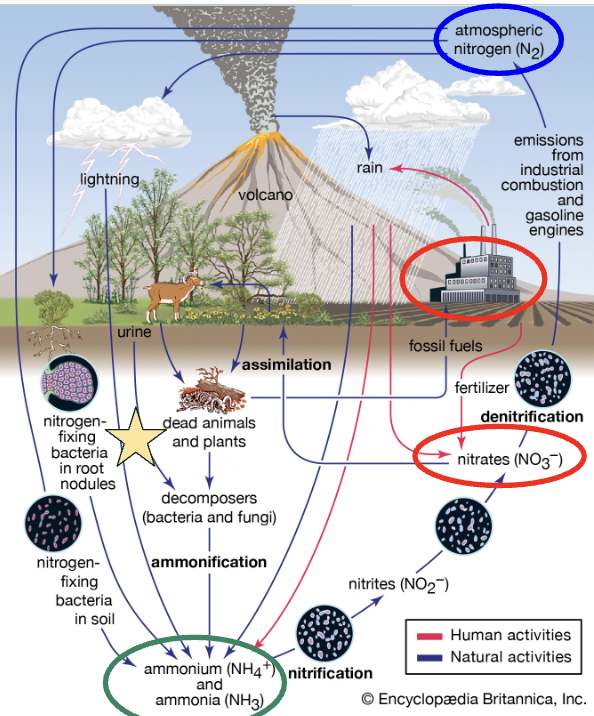
Unit 1 - The Living World - Ecosystems (6-8%): Biotic Fixation
Certain bacteria that live in the soil, or in symbiotic relationship with plant root nodules convert N2 into ammonia (NH3)
(Living things turn N2 into ammonia NH3)
Rhizobacteria live in root nodules of legumes (peas, beans) & fix N for them in return for amino acids from the plant (mutualism)
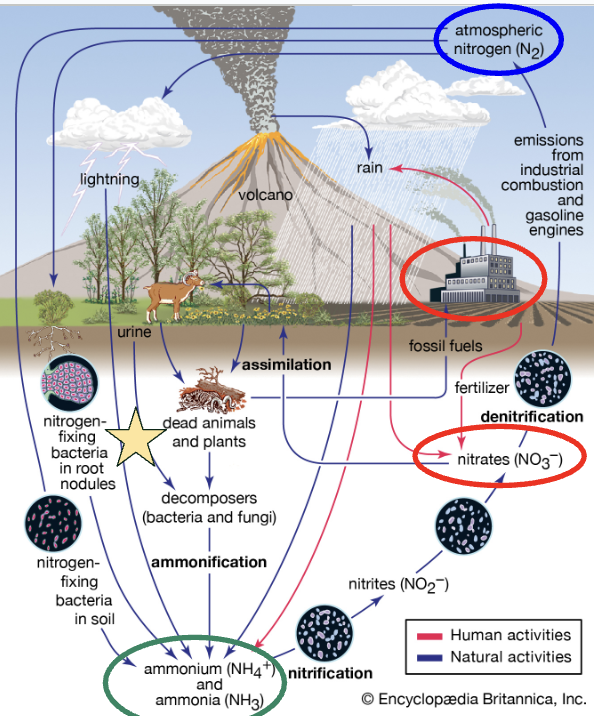
Unit 1 - The Living World - Ecosystems (6-8%): Abiotic Fixation
Lightning converts N2 gas into nitrate (NO3) and FF combustion converts N2 gas into ammonia (NH3)
(Lightning turns N2 into nitrate NO3 and FF combustion turns it into ammonia NH3)
NH3 is added to synthetic fertilizer and applied to agricultural soils (where it’s converted into nitrate)
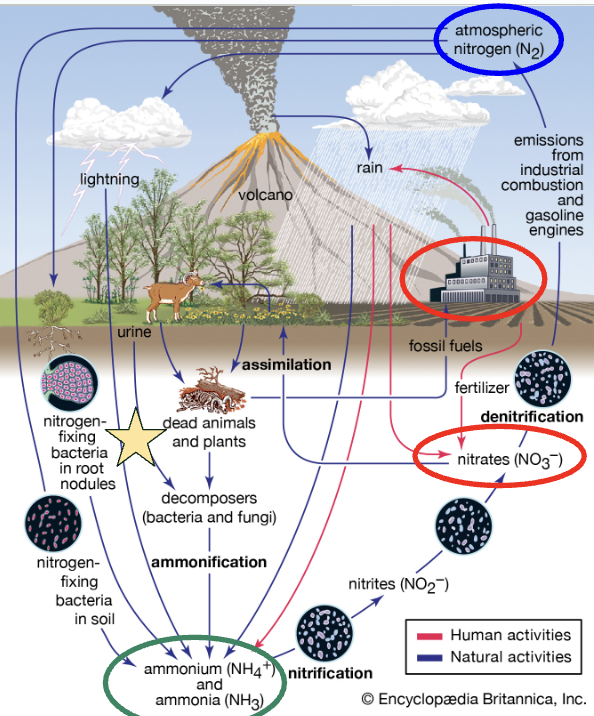
Unit 1 - The Living World - Ecosystems (6-8%): Other N Cycle Steps
Assimilation
Ammonification
Nitrification
Denitrification
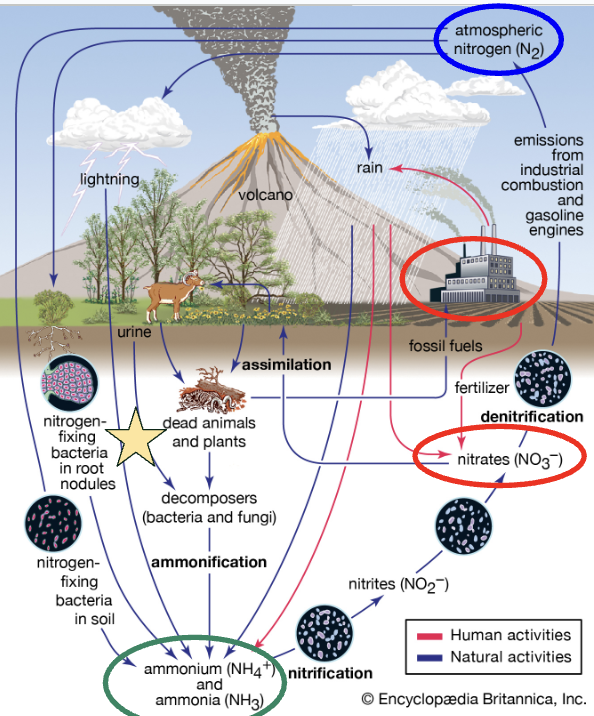
Unit 1 - The Living World - Ecosystems (6-8%): Assimilation
Plants & animals taking N in and incorporating it into their biomass
Plant roots take in NO3 or NH3 from soil’ animals assimilate N by eating plants or other animals

Unit 1 - The Living World - Ecosystems (6-8%): Ammonification
Soil bacteria, microbes & decomposers converting waste & dead biomass back into NH3 and returning it to soil
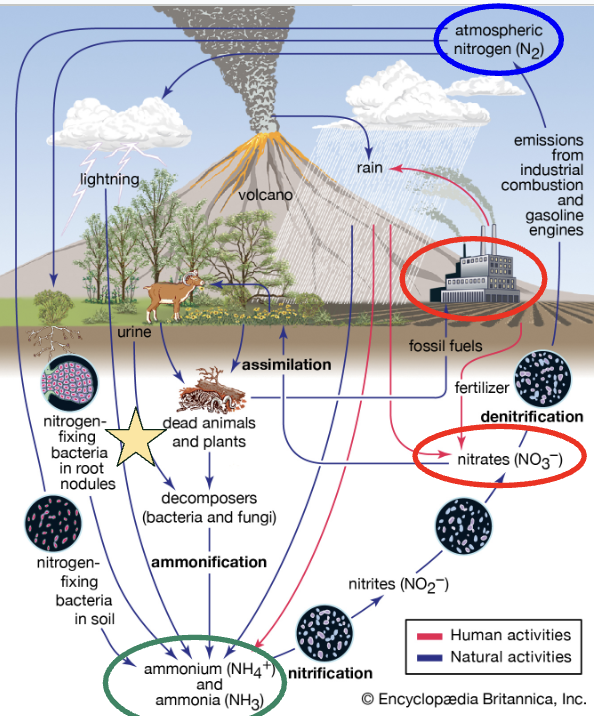
Unit 1 - The Living World - Ecosystems (6-8%): Nitrification
Conversion of NH4 and NH3 into nitrite (NO2) then nitrate (NO3) by soil bacteria
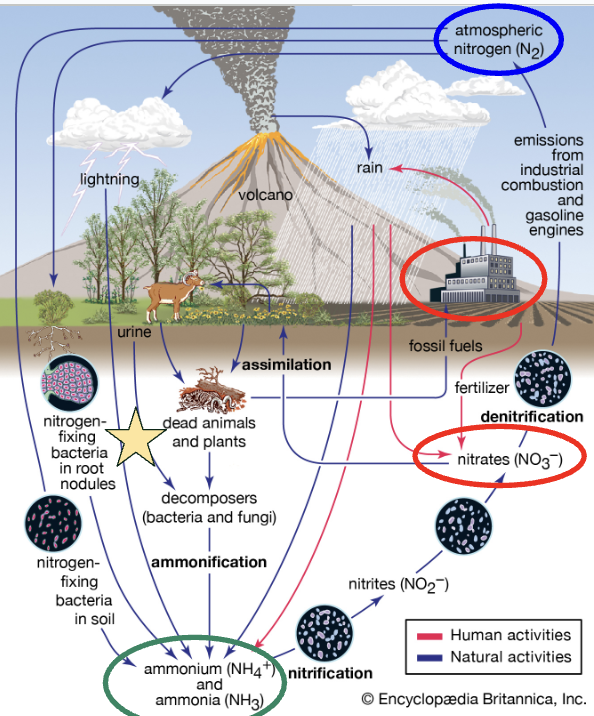
Unit 1 - The Living World - Ecosystems (6-8%): Denitrification
Conversion of soil N (NO3) into nitrous oxide (N2O) gas which returns to atmosphere
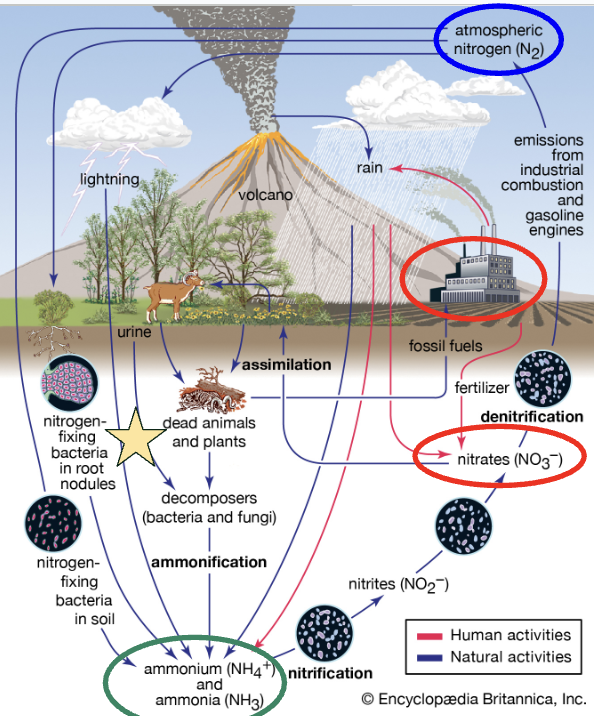
Unit 1 - The Living World - Ecosystems (6-8%): Human Impacts on N Cycle
Climate
Leaching & Eutrophication
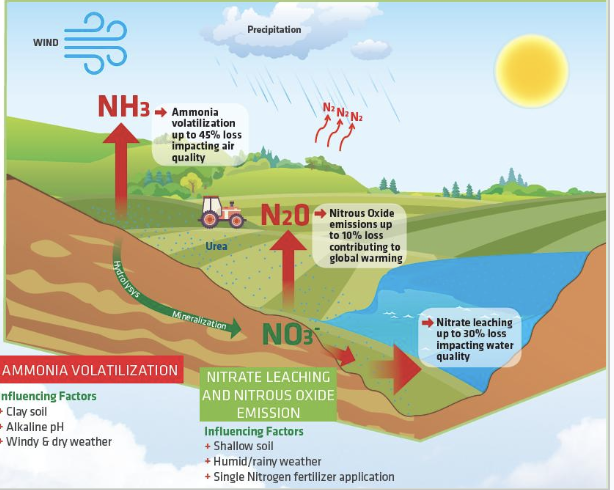
Unit 1 - The Living World - Ecosystems (6-8%): Climate
N2O (nitrous oxide) = greenhouse gas which warm earth’s climate
Produced by denitrification of nitrate in agricultural soils (especially when waterlogged/over watered)
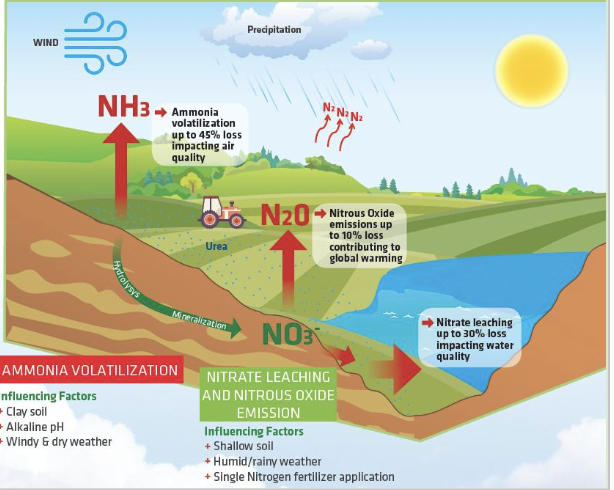
Unit 1 - The Living World - Ecosystems (6-8%): Leaching & Eutrophication
Synthetic fertilizer use leads to nitrates (NO3) leaching, or being carried out of soil by water
Nitrates runoff into local waters, causing algae blooms that. block sun & kill other aquatic plants
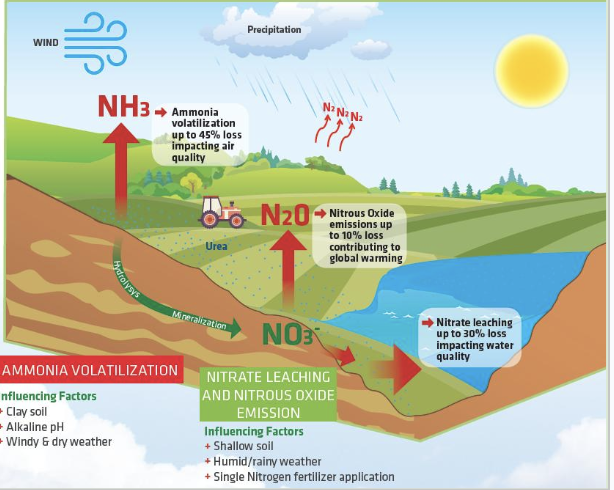
Unit 1 - The Living World - Ecosystems (6-8%): Phosphorous Cycle Basics
Movement of P atoms & molecules b/w sources & sinks/reservoir
Rocks & sediments containing P minerals = major reservoirs
P cycle is very slow compared to C/H2O/N cycles
Takes a long time for P minerals to be weathered out of rocks & carried into soil/bodies of water
No gas phase of P (doesn’t enter atmosphere)
B/c it cycles so slowly, it is a limiting nutrient, meaning plant growth in ecosystems is often limited by P availability in soil/water
P is needed by all organisms for DNA, ATP (energy), bone & tooth enamel in some animals
Unit 1 - The Living World - Ecosystems (6-8%): Phosphorous Sources
Major natural source of P is weathering of rocks that contain P minerals
Wind & rain break down rock & phosphate (PO4-3) is released and dissolved into water; rain water carries phosphate into nearby soils & bodies of water
Weathering is so slow that P is often a limiting nutrient in aquatic & terrestrial ecosystems
Synthetic (human) sources of P = mining phosphate minerals & adding to products like synthetic fertilizers & detergents/cleaners
Synthetic fertilizers containing phosphates are added to lawns or agricultural fields; runoff carries P into nearby bodies of water
Phosphates from detergents & cleaners enter bodies of water via wastewater from homes
Unit 1 - The Living World - Ecosystems (6-8%): Assimilation & Excretion/Decomposition
Just like N. P is absorbed by plant roots & assimilates into tissues; animals assimilate P by eating plants or other animals
Animal waste, plant matter & other biomass is broken down by bacteria/soil decomposers that return phosphate to soil
Assimilation & excretion/decomposition form a mini-loop within P cycle just like assimilation & ammonification in N Cycle, photosynthesis & respiration in C Cycle
Unit 1 - The Living World - Ecosystems (6-8%): Sedimentation & Geologic Uplift
Phosphate doesn’t dissolve very well into water; much of it forms solid bits of phosphate that fall to the bottom as sediment (sedimentation)
P sediments can be compressed into sedimentary rock over long time periods by weight of overlying water
Geological uplift
Unit 1 - The Living World - Ecosystems (6-8%): Geological Uplift
Tectonic plate collision forcing up rock layers that form mountains; P cycle can start over again with weathering & release of phosphate from rock
Unit 1 - The Living World - Ecosystems (6-8%): Eutrophication (Too Much N & P)
**Can occur from fertilizer runoff, human/animal waste contamination
B/c they’re limiting nutrients in aquatic ecosystems, extra input of N & P leads to eutrophication (excess nutrients) which fuels algae growth
Algae blooms covers surface of water, blocking sunlight and kills plants below surface
Algae eventually die-off; bacteria that break down dead algae use up O2 in the water (b/c decomposition = aerobic process)
Lower O2 levels (dissolved oxygen) in water kills aquatic animals, especially fish
Bacteria use up even more O2 to decompose dead aquatic animals
Creates positive feedback loop: less O2 —> more dead organisms —> more bacterial decomposition —> less O2
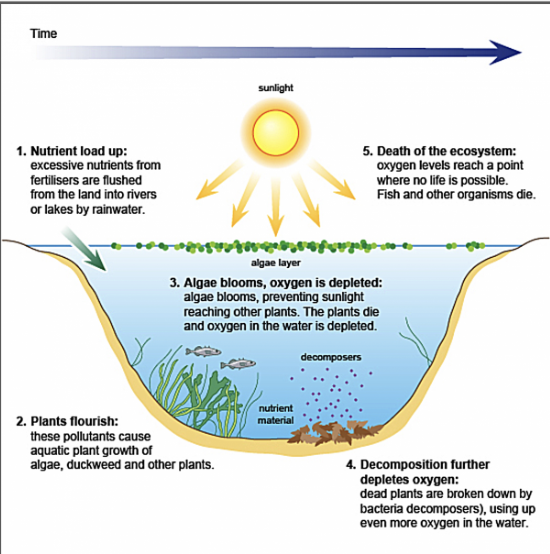
Unit 1 - The Living World - Ecosystems (6-8%): Decomposition
the natural process where organic matter, like dead plants and animals, is broken down into simpler substances by decomposers like bacteria, fungi, and worms. This process plays a crucial role in nutrient cycling and the breakdown of waste materials.
Unit 1 - The Living World - Ecosystems (6-8%): Water Cycle Overview
Movement of H2O (in different states) between sources & sinks
State of matter (solid/liquid/gas) as well as where water is moving are key in H2O cycle
Ex: precipitation = atmosphere (gas) —> land or surface water (liquid)
Energy from sun drives the H2O cycle
Ex: heat from sun causes liquid water in ocean to become a gas (evaporation) in atmosphere
Ocean = largest water reservoir
Ice caps & groundwater are smaller reservoirs, but contain fresh, useable water for humans
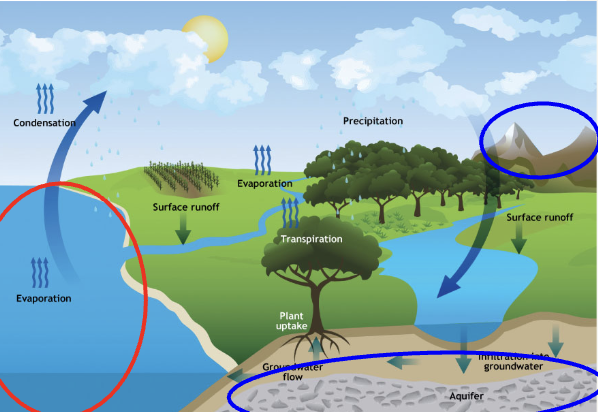
Unit 1 - The Living World - Ecosystems (6-8%): Evaporation & Evapotranspiration
2 main sources of water (process that cycle it from liquid on earth back into the atmosphere)
Sometimes called “vaporization” since liquid water becomes water vapor (gas) in atmosphere
Transpiration
Evapotranspiration
Both processes are driven by energy from the sun
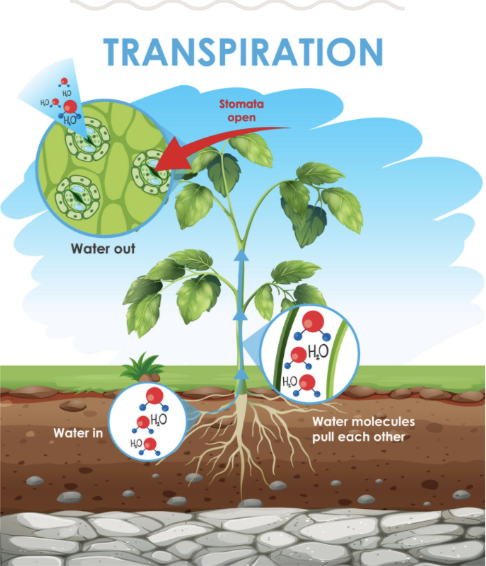
Unit 1 - The Living World - Ecosystems (6-8%): Transpiration
Process plants use to draw groundwater from roots up to their leaves
Leaf openings called stomata open, allowing water to evaporate into atmosphere from leaf
Movement of H2O out of lead creates low H2O potential in leaf, putting H2O up from roots
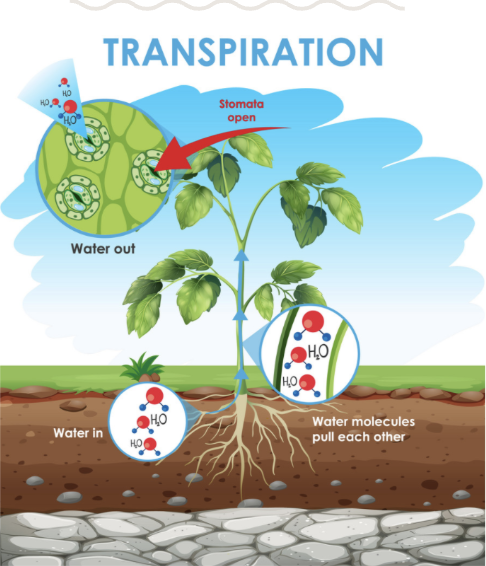
Unit 1 - The Living World - Ecosystems (6-8%): Evapotranspiration
Amount of H2O that enters atmosphere from transpiration & evaporation combined
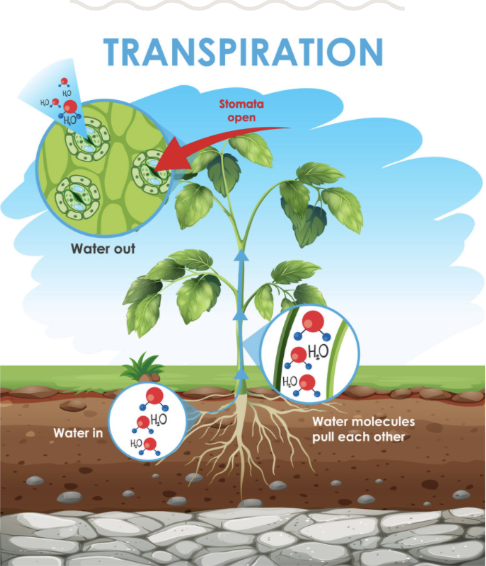
Unit 1 - The Living World - Ecosystems (6-8%): Runoff & Infiltration
Precipitation (rain) either flows over earth’s surface into a body of water (runoff or trickles through soil down into groundwater aquifers (infiltration)
Groundwater (aquifers) & surface waters (lakes/rivers) are important freshwater reservoirs for humans & animals
Precipitation recharges groundwater through infiltration, but only if ground is permeable (able to let water pass through)
Runoff recharges surface waters, but can also carry pollutants into water sources
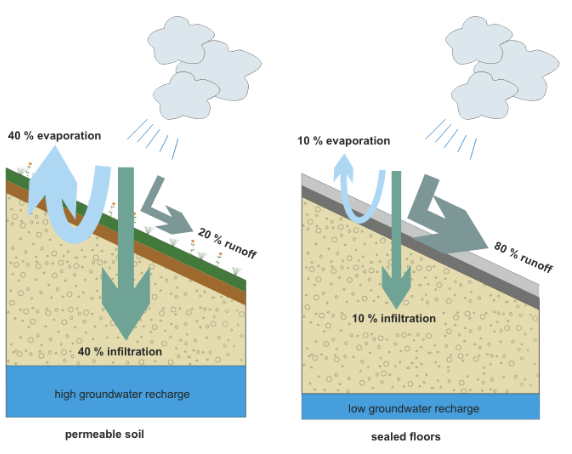
Unit 1 - The Living World - Ecosystems (6-8%): Percolation
the flow of water through soil and porous or fractured rock (tunnel)
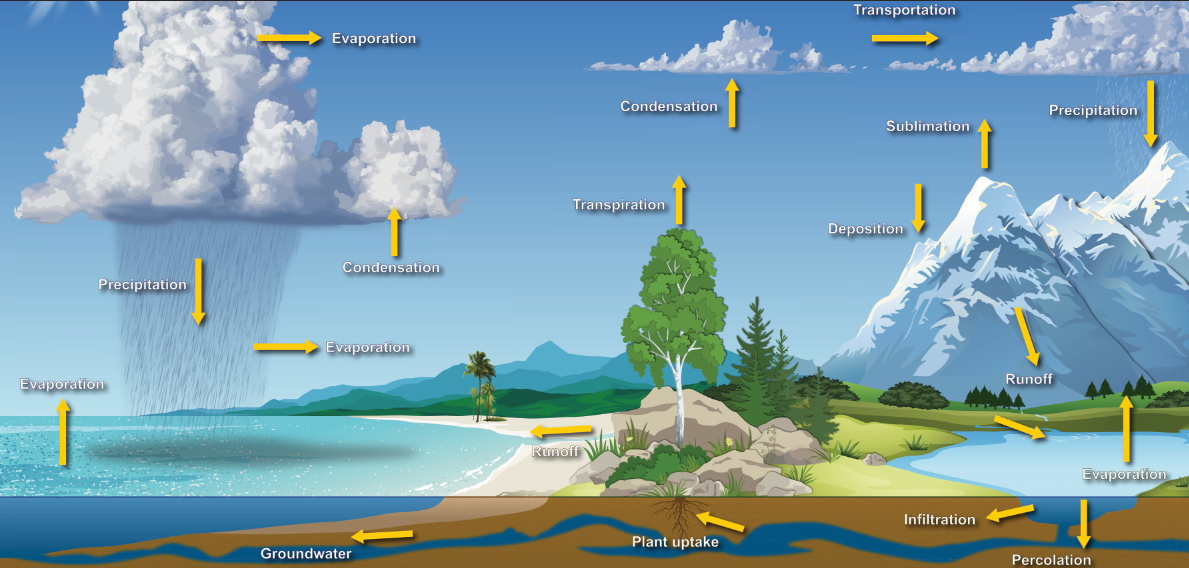
Unit 1 - The Living World - Ecosystems (6-8%): What is the quickest to slowest gas cycle?
Water Cycle
Nitrogen Cycle
Carbon Cycle
Phosphorous Cycle
Unit 1 - The Living World - Ecosystems (6-8%): Primary Productivity
Rate that solar energy is converted into organic compounds via photosynthesis over a unit of time
Aka: rate of photosynthesis of all produces in an area over a given period of time
Since photosynthesis leads to growth, you can also think of PP as the amount of plant growth in an area over a given period of time
Unit 1 - The Living World - Ecosystems (6-8%): PP Basics
units: kcal/m²/yr.
kcal = energy
m² = area
yr. = time
High PP = high plant growth = lots of food & shelter for animals
Ecosystems with high PP are usually more biodiverse (more diversity of species) than ecosystems with low PP
Unit 1 - The Living World - Ecosystems (6-8%): Calculating PP
NPP = GPP - RL
NPP = Net Primary Productivity
GPP = Gross Primary Productivity
RL = Respiration Loss
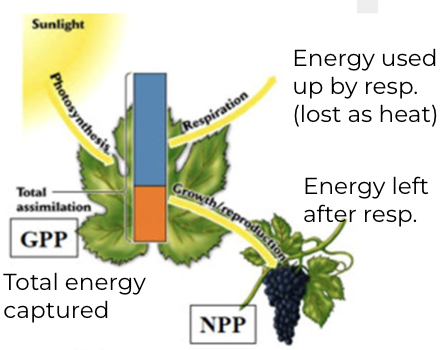
Unit 1 - The Living World - Ecosystems (6-8%): Net Primary Productivity (NPP)
The amount of energy (biomass) leftover for consumers after plants have used some for respiration
Think of NPP as the actual amount of the plant’s paycheck it keeps after taxes
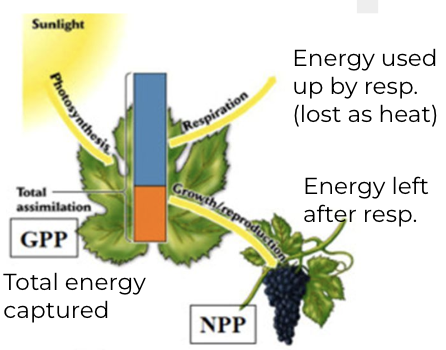
Unit 1 - The Living World - Ecosystems (6-8%): Gross Primary Productivity (GPP)
The total amount of sun energy (light) that plants capture and convert to energy (glucose) through photosynthesis
Think of GPP as the total paycheck amount the plant earns
